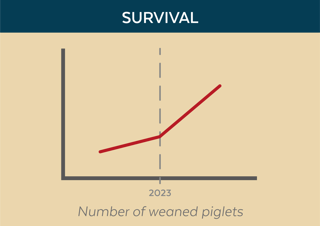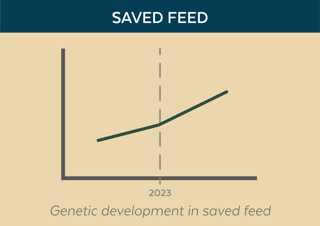The basis for our breeding program - DGENES
The Danish Genetics breeding program builds on a foundation of the latest technologies, innovation and genetic expertise that are present in Danish Genetics Evaluation System (DGENES) which has been developed in collaboration with the science- and technology company AbacusBio and Center for Quantitative Genetics and Genomics of Aarhus University.
The breeding program is designed to consider traits of interest that provide economical profitability for actors throughout the entire pork production value chain. The breeding goal trait emphases are obtained from Danish Genetics’ bio-economic model that considers the market trends, resulting in an economical breeding index.

The optimized breeding program will result in strong, efficient, robust, and long-lifespan sows for sow producers, delivering more weaned piglets by a higher piglet survival and heavier piglets at weaning that require fewer days to growing period. Thereby sows that produce more meat per sow space for less production cost. The trait improvement package also aims to maximize profit for slaughter pig producers through efficiency, growth, and carcass quality yielding more lean meat per carcass in a shorter period, for less feed.
Breeding goal Landrace and Yorkshire
Danish Genetics’ breeding program for the maternal lines, Danish Yorkshire, and Danish Landrace, is designed with sow producers in mind to produce the most optimal F1 sow. The objective is to produce super sows with characteristics of producing more meat per year sow, give birth to easy handling strong and robust piglets. Therefore, the maternal lines have specific focus on reproduction (boar fertility and viable piglets), robustness (longevity and strength), and mothering ability (piglet survival and early growth). In addition, the maternal lines provide half of the genetics for the commercial hybrid finisher pig and hence, growth, efficiency and carcass quality are highly emphasized as part of the breeding program for maternal line. For the Landrace and Yorkshire, the breeding objectives include the backfat criteria to preserve a constant level. This approach reflects our commitment to a balanced breeding strategy that not only enhances efficiency but also reinforces the sows' robustness.


Breeding goal Duroc
The breeding objective for the terminal line of Danish Duroc is to maximize the profitability for slaughter pig producers, slaughterhouses, meat processing companies and retailing. This is achieved by putting emphasis on trait categories such as efficiency, growth, boar fertility, survivability, and carcass quality.

The sow effect on number of viable piglets at day 1 of farrowing, no. piglets/litter.

The sow effect on percentage of viable piglets 21 days after farrowing, %/litter

Amount of feed not used for growth and carcass quality, g/day
At Danish Genetics, our breeding strategy, which was updated in 2023, is centered on precision and efficiency, with a special focus on optimizing feed utilization through our "Saved feed(Residual feed intake)" breeding goal. Our approach balances the importance of survivability with the need for substantial litter sizes, ensuring a holistic development of our animals. Our carefully crafted index ranking underlines these priorities, placing a significant emphasis on piglet survival, thereby promoting the birth of robust piglets. This focus guarantees not only a high quantity of piglets but also enhances their survivability, supporting the wellbeing of our sows and their offspring. The result is a harmonious blend of strong sows, resilient piglets, and overall superior outcomes, making the management of these processes more streamlined and effective for all involved.











